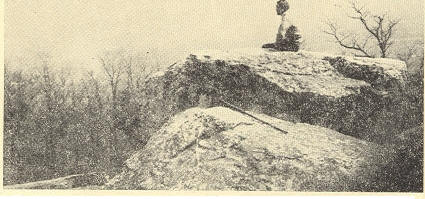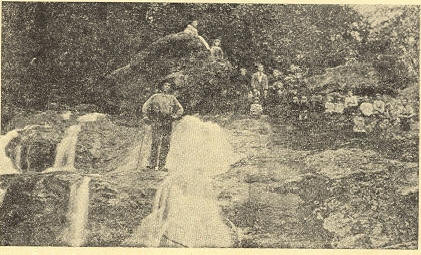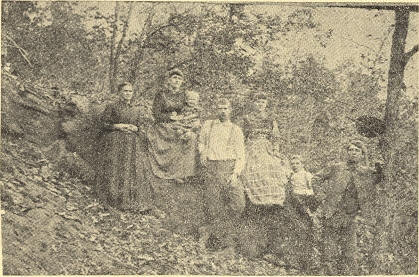|
Gateway to the Mountains
George Wireman Chapter 39: Outstanding Points of Interest
Located among the foothills of the Catoctin spur of the Blue Ridge Mountains, Thurmont takes great pride in
offering many points of interest. The scenic and historic is combined in so many instances ... Here a century old church, there a covered
bridge in everyday use . . . Modern highways following Indian trails and an old stone house where the first friction matches ever made in
America, had their beginning ... A mountain retreat used by the President of the United States . . . Trout streams located in the beautiful
Catoctin Mountains . . . A national as well as a State park . . . all provide relaxation and variety to the visitor and resident alike.
This chapter is designed to provide some interesting facts and to better acquaint the reader with the many
points of interest which the community has to offer, some of which have gained national recognition.
Catoctin Mountain Park
The broad sweep of the Catoctin Mountains stretches from the southern end of Frederick County to the rather
abrupt slope of Carrick's Knob which dominates Emmitsburg. It is a panorama of which the Nature lover never tires, unmovable but friendly.
There are changing lights and shades of full sunshine as well as shadows created by the clouds, somber under stormy skies, but patiently
re-minding the observer "We are here to stay." The beauty and strength of the mountains with the rich colorings of green, deep blue and, under
certain atmospheric conditions, azure, charm the eye and refresh the mind, a picturesqueness constant and yet changing as the seasons come and
go. The fresh green of spring and summer is followed by the rich colors of Autumn's tapestry, and in winter the snow covering the ground
beneath the leafless trees suggests Nature's protection under winter's blanket.
Catoctin Mountain Park was first established in 1935, by the Federal Government as the Catoctin Recreation
Demonstration Area to show how submarginal farm lands and poorly managed forest lands could be converted into valuable recreational resources.
Ranging in elevation from 700 to 1,880 feet above sea level, the park's 5,765 acres are on the easternmost ridge of Maryland's Appalachian
Province. Park visitation has been increasing steadily, and the park is rapidly becoming one of the most popular areas in the State for
hiking, fishing, picnicking, camping and nature study. Several overlooks which command outstanding views of the valleys and ridges include Hog
Rock, Wolf Rock and Chimney Rock.
It is here in Catoctin Mountain Park that the famous presidential mountain retreat, Camp David, is located.
At this mountain retreat, many world leaders have been guests of the President of the United States and enjoyed the many forms of recreation
which the camp provides.

The author views Thurmont and surrounding area from atop Chimney Rock.
It is here that he spent many enjoyable hours with his father
Job Corps Conservation Center
Catoctin Mountain Park has a Job Corps Conservation Center activity which was the first such center to be
established in the nation. This center is composed of about 29 staff employees, including a di-rector, teachers, counselors, work foremen, and
others, and a complement of 100 job corpsmen.
The camp is located within the park on the Manahan Road; and visitors are welcome to stop there at the Center
Director's Head-quarters for detailed information. Corpsmen are assigned to work projects which are approved and programmed in accordance with
the park's master plan development schedule. The corpsmen are rendering favorable conservation service to the park while being taught useful
trades and crafts as well as classroom subjects.
Catoctin Mountain Park is a unit of the National Park Service, United States Department of the Interior.
Cunningham Falls State Park
The Cunningham Falls State Park of 4,446 acres, located in the heart of the beautiful Catoctin Mountains, is
one of Maryland's newest and largest areas developed for outdoor recreation.
It was created in 1954 when the Federal Government deeded to Maryland about half of the Catoctin Recreation
Demonstration Area. The Resettlement Administration had purchased it in 1935 as one of the 33 nation-wide federal demonstrations of
submarginal land for public recreation.
The northern half of the tract, now called Catoctin Mountain Park, is still retained by the Federal
Government and under the jurisdiction of the National Park Service.
Many people have been under the impression that Cunningham Falls was named after an early owner, but this is
not true. Dr. Harry D. Bowman, a friend of the author, has spent many hours of re-search on this subject and it is now an established fact
that at no time was the falls owned by Cunningham. Records to support this claim may be found in the land records of Frederick County.
The first purchase of the land, which included the falls, consisted of 350 acres and was deeded to Archibald
McAfee, Sr. on September 16, 1807. A map in the Frederick Library, dated 1858, clearly shows that the McAfees lived at the top of the falls
and the property was owned by John McAfee at this time. The McAfees referred to the falls as Hunting Creek Falls but all others called it
McAfee Falls, after the owners.

Reuben McAfee, grandson of Archibald McAfee, stands at the top of "McAfee Falls".
The original foundation of the McAfee homestead still stands not far from this site

The McAfee families were well known in American pioneer history. Pictured here, reading left to right, is Hannah Lewis, Ethos Flair, holding
her daughter Lily, Charlie Flair, Rose Ann McAfee, now 94, Charles McAfee, and Reuben McAfee, all members of the McAfee clan
On September 15, 1888, Archibald McAfee's widow had sale and the property including the Falls was purchased
by her grandson Reuben McAfee, who maintained ownership until the property was acquired by the Federal Government in 1935, as part of the
Catoctin Recreation Demonstration Area. Later the State of Maryland acquired an additional 250 acres of land from the McAfees. This made a
total of 750 acres which the McAfees surrendered for park use. At one time they owned over 1,000 acres of mountain land.
Just recently, through the efforts of Dr. Bowman and members of the McAfee family, the name "Cunningham" was
dropped and today this beautiful waterfall is officially recognized by its original name, "McAfee Falls."
The Algonquian Indians gave the name of "Catoctin" to the high wooded ridges and tumbling streams which was
once their favorite hunting grounds. Some claim the name means "the old hill or mountain", but others believe it meant "the place of many
deer." At any rate, deer and other small game are still plentiful here, and some of the best trout fishing in Maryland can be found in the
mountain streams.
Cunningham Falls State Park is maintained by the Department of Forests and Parks, and the area offers picnic
sites, camping areas, bathing and boating facilities and parking areas. A minimum of rules and regulations is imposed solely for the purpose
of giving the best service to the greatest number of people.
Crow's Nest Campground
Crow's Nest Campground is situated on 54 acres of land which has been the site of several businesses through
the years. Included among these were Stern's Tannery, Lynn's Pottery and a popular country boarding house in the early 1900's.
Crow's Nest Lodge is one of the first privately operated camp-grounds ever to be established in Maryland. In
1958 it began with six campsites and today it has over 100, with future plans calling for additional ones. Camping families are provided with
large campsites bordering Hunting Creek and on a wooded slope overlooking the beautiful Frank Bentz Memorial Pond. This pond is stocked with
trout and is open to the public for fishing. A spring-fed pond provides swimming for the campers. Badminton, volleyball and horse-shoe courts
are maintained for camper recreation. Over 10 miles of scenic foot trails wind through the adjoining Catoctin Mountains to panoramic overlooks
on the higher elevations. These provide hiking trips, rock collecting and nature study for those who enjoy this type of recreation.
The central location of Crow's Nest Lodge in an area of especial historical significance, offers the camper
an opportunity to visit such points of interest as Gettysburg, Harper's Ferry, Antietam Battle-field, Washington, D. C., Baltimore and
Frederick; all of which are within easy driving distance.
Ole Mink Farm Campground
With the rapidly growing popularity of family camping there came an inevitable demand for a different type of
camping area, one which combined the best in wilderness camping with the comforts and recreational facilities of a resort. Most of today's
camping families appreciate the "little extras" which enable them to enjoy outdoor living to its fullest. At the "Ole Mink Farm", the natural
beauty of the wilderness has been preserved, yet no expense has been spared to provide these camping comforts. Here, tucked away high in the
beautiful Catoctin Mountains one will enjoy wilderness camping with all the conveniences of a modern resort.
Each campsite is provided with sturdy eight-foot tables and a permanent fireplace of brick or field stone.
Water is piped to outlets throughout the area. At the Headquarters Building there are toilets, lavatories, and showers. An oil-fired hot water
system provides continuous hot water for the lavatories and showers. There is a large recreation room with ping pong and pool tables, as well
as a juke box to provide music. A camp store provides the campers shopping needs. Outside there is a children's play area as well as courts
for horse-shoes, badminton and tether-ball. Swimming is provided in a large springy fed, filtered pond with a children's beach. Hiking and
exploring for the rugged type is also available. Excellent fishing in nearby streams and ponds has made the "Ole Mink Farm" a popular resort
for sportsmen.
Chapter Index
| Chapter 40: Outstanding Citizens
If you have any Information or
historical news clippings on events in
the Thurmont Area, Please send them to us so we can
included them in our archives. E-mail us at:
history@mythurmont.net |